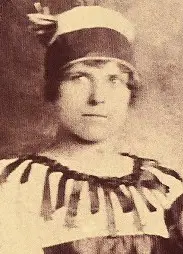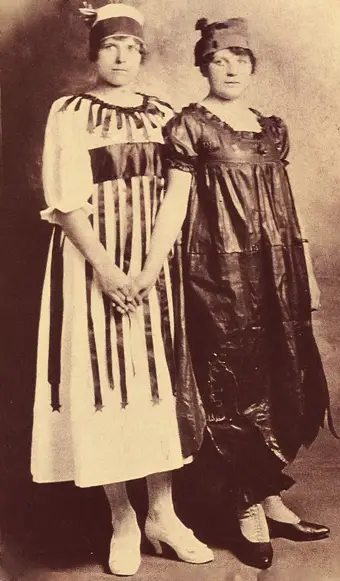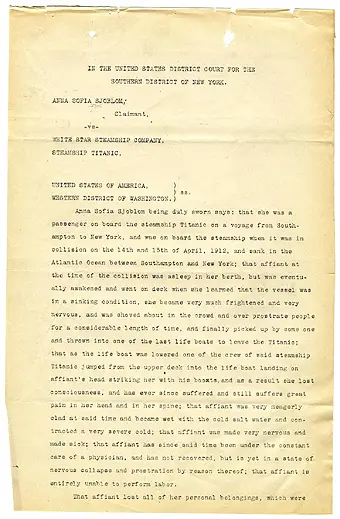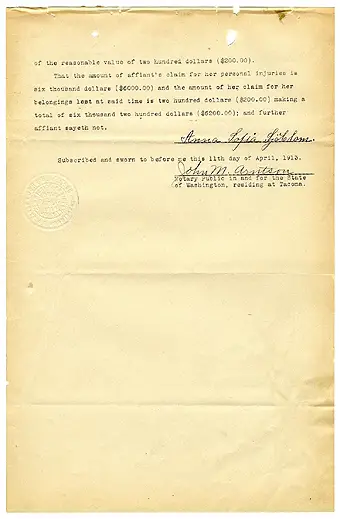Miss Anna Sofia Sjöblom
Third Class Passenger

“When we rowed away from the Titanic, my face was toward the sinking steamship and the things I saw I will never forget. I saw an officer shoot himself through the temple with a revolver.”
Miss Anna Sofia Sjöblom, 18, from Finland, was traveling in third class to meet her father, Gabriel Gustafson in Olympia Washington. Her time aboard Titanic was not particularly pleasant as not only could she not speak English but she was seasick. April 14, 1912 was Anna'a 18th birthday. After the collision she made her way from third class to the boat deck and was able to enter lifeboat no.16.
Sjöblom gave an account to the Tacoma Daily News of April 30, 1912 (partly reprinted in The Visitor's Guide to Titanic: The Artifact Exhibit by the King County (Washington) Journal Newspapers, reprinted in full in The Titanic Commutator Vol. 19 No. 4). A full vesion of her account was published in the Olympia Daily Recorder, of April 30th, 1912:
OLYMPIAN SAID TO BE TITANIC VICTIM-- GIRL SURVIVOR ARRIVES HERE
One of the most dramatic and thrilling narratives of the scenes attending to the disaster of the Titanic and the perishing of more than 1,600 people, is that related by Anna Sjoblom, an 18-year-old girl who arrived in Tacoma yesterday on her way from Finland to join her father and brother, Gabriel Gustafson and Dan Gustafson, who work in a logging camp at Matlock, in Mason County. Mention was made in the local papers last week of the fact the Gustafsons, then on a visit to Olympia, had just received word of the safety of the girl. Miss Sjoblom is staying at the home of her uncle and aunt, Mr. and Mrs. Andrew Nelson of Tacoma, and will remain there for the present.
The Tacoma Ledger this evening contains an interesting interview with the girl, obtained through the aid of Mrs. Nelson as interpreter.
According to the girl's story, one of her companions on the voyage on the Titanic was a Fred Johnson, formerly of Olympia, who had recently taken his family to Finland, and was on his way back to Puget Sound to purchase a new home. Two other young men from her home town were aboard, and the Ledger story states that all her friends were drowned, which would indicate the death of Fred Johnson. Inquiry here today failed to secure information as to his former residence here.
April 14, the day of the Titanic wreck, was Miss Sjoblom's 18th birthday. She was a third cabin passenger and was surrounded by immigrants of every nationality. During the day and evening there were dancing and festivities among her fellow passengers, but, homesick and alone, the young girl remained away from the frolics of her shipmates and had retired early.
"I woke up when the boat struck the iceberg," she said last night speaking the Swedish language to Mrs. Matilda Nelson, who translated her sentences. "Everyone became excited at once. I got up and put on some clothes so that I could go outside. When outside, I had no time to go back again. My railroad ticket to Tacoma and a small amount of money was sewed in a little bag and hung around my neck, so that I could not lose it."

Anna Sofia Sjoblom (left), photo: Gavin Cameron Bell
(Click image to enlarge)
Sees Water Rising
"Water began coming up where I was in a short time, and I fought my way to get above it. I went up the stairs to the deck above and then tried to climb clear to the top. I climbed as far as a window, where I hung by my fingers. I couldn't go farther and I couldn't go back to the deck again. I waited there some minutes. I was awfully afraid that I would fall and kill myself. Then an officer of the ship saw me and dragged me up to the next deck."
"Everywhere everybody was confused. I tried to get into a lifeboat and was pushed back. The boats kept filling up and going over the side, and it seemed as though I would go down with the ship. I remember watching a little boy about 13 years old, whose parents had gone off in one of the lifeboats. He slipped into a boat and was thrown back upon the deck by a sailor. He crept into another boat and again they threw him back to the deck. The third time he slid down boats. He slipped into a boat and was saved. I talked with him afterwards."
Next to Last Boat
"The boat that I got into finally was the next to the last boat launched. There must have been 50 people in it. It was so crowded that we sat on each other's laps, three deep. While the boat was being lowered, a man jumped into it from the deck above. He came down feet first on my head and nearly broke my neck. He splawled over the people in the lifeboat and nearly fell overboard. I was in intense pain for hours after he had jumped on me."
"The lifeboat was so crowded that I sat on a man's knee and had a woman on my lap. Several others did the same. There wasn't room for another person in the boat. When we rowed away from the Titanic my face was towards the sinking steamer, and the things I saw I never will forget."
Saw Officer Shoot Himself
"I saw an officer shoot himself through the temple with a revolver. I saw passengers throw themselves overboard, shrieking for help. I saw men in the water, floating on lifebelts, who were crusted with ice so thick that you could hardly make out their faces. I saw dead bodies floating about, covered with ice. Oh, it was too terrible to talk about."
"I watched the big steamer every second of the last few minutes she was afloat. The reports were wrong when they say the boilers exploded. The ship just gradually sank in front, the bow went down out of sight, the lights, the low ones first and then the higher around the side of the hull, blinked out, one after the other. Then the steamer, without a sound, except the shrieks of the people still on board, stood right up on end. It stood there several moments, then slid straight down into the water."
Sinking Was Terrible
"The sounds as the ship sank were the most awful sounds I ever heard. I never expect to hear worse. When the boat first began to sink, the people on board began to shriek and wail and moan. As it went down farther and farther the shrieks arose louder and louder and more awful. Then, as the boat began to tip up on end, the sound of cries was like something terrible. I still hear it," the girl shuddered as she tried to explain.
"A terrible thing occurred right in our own lifeboat. A young couple, well dressed and refined were in the boat when it was lowered. The young woman fell overboard. She struggled about and finally the men in the boat pulled her aboard. Her husband, a fine looking young man with black hair and beautiful features, sat in a seat in the middle of the boat, and helped to make her comfortable. Then, a few minutes after she had been pulled aboard, she collapsed, fell forward and died. She lay on the bottom of the boat, her face upward. We were all of us powerless to move, so crowded was the boat."
"The young man just sat there and stared at her. He sat there without moving for an entire hour. At the end of that hour his hair, which had been very black before, had turned to all white. He was about 30 years old. At the end of an hour he looked like he was 70. He never spoke or moved after his wife died. The woman's dead body remained in the boat with us until we were rescued. After we had been taken on board the Carpathia, and the young man had been taken aboard, he collapsed on the deck of the rescue ship, fell over, and died. I never learned who he was. His hair had become white just like snow, and I doubt if any of his relatives or friends would know his body."
Miss Sjoblom reached New York on the steamer Carpathia, April 18, and remained there in the Swedish immigrant mission until last Tuesday, when she left for Tacoma. With her on the trip West were Paul Johnson and Oscar Hedman, countrymen who left the train at St. Paul, and Bertha Neilson, a countrywoman who came as far West as Montana. They were the first survivors of the wreck to come as far West and were objects of great interest on the train.
Body Crusted With Ice
Paul Johnson, one of her companions on the train, had remained in the ice-cold water, supported by a lifebelt, for six and one-half hours. He was of a powerful physique, or he could never have withstood the strain. When he was hauled aboard the Carpathia there was a half-inch crust of ice on his limbs and his hair was a mat of solid ice. He collapsed and was in bed for two days, but recovered quickly and was able to leave the ship unassisted when she arrived in New York.

Sjöblom asked for $6200 in a joint claim - page 1.
Image: The Slate.com (Click image to enlarge)
Fight for Life in Water
Miss Sjoblom said that the waters about the wrecked steamer were literally covered in bodies after the Titanic sank. She saw a missionary, a large man in clerical clothing, floating about on a lifebelt. The bodies drifted about him so closely that he was forced to push them away from him with his hands. She said that other people in the water swam to the missionary, and tried to grasp his clothing for support. In order to save himself, he had to knock them roughly away. The missionary, she said, was later saved.
None of Miss Sjoblom's relatives in Tacoma knew she was on board the Titanic, and were not expecting her until they received a telegram from her Sunday. Her passage money had been sent by her father, Gabriel Gustafson, brother-in-law of Andrew Nelson of Tacoma, and her coming to Tacoma was to have been a surprise for her uncle. Her mother and several brothers and sisters are still in Finland. She will remain in Tacoma with the Nelsons.

Sjöblom asked for $6200 in a joint claim - page 2.
Image: The Slate.com (Click image to enlarge)
So how accurate is Sjöblom's account of an officer suicide? It must first be noted that the account was "obtained through the aid of Mrs. Nelson as interpreter." The account of the sinking is fairly straightforward, however her story of the young woman in the lifeboat who falls overboard, is pulled back in and then dies, and her husband who turns white and then himself dies aboard the Carpathia, falling overboard, does seem quite improbable and possibly more due to the active imagination of an 18 year old girl. Her dramatic description of the aftermath of the sinking and the number of bodies seen also lacks support in other similar survivor accounts. (8.)
Interestingly, after arriving in America, her name is among one of "many claims jointly filed against the ship’s owners by people who made it through the disaster" Sjöblom claimed that a crew member then jumped into the boat and landed on her head, “striking her with his boots,” and as a result she had “ever since suffered and still suffers great pain in her head and in her spine." (Rebecca Onion, The Slate, April 16, 2013) Sjöblom asked for $6200 and while we do not know if she received it we do know that she later married Gordon Kinkaid and lived at 1220 S. Jefferson St. in Olympia from 1956 until her death in 1975. Anna's Titanic boarding pass, worth six figures on the auction circuit, became the object of a "custody battle" in the late 1990s. Anna died on 3 November 1975 aged 81. (8.)
But it must be noted that in this claim and also in her correspondence later with author Walter Lord she does not mention the officer suicide, or the lifeboat and Carpathia deaths. Although this does not necessarily invalidate her earlier accounts, her mention of the suicide should also be taken in context of this.
Verdict: